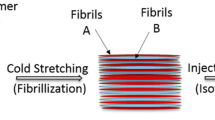Abstract
Shape memory polymers (SMPs) are increasingly being considered for use in minimally invasive medical devices. For safe deployment of implanted devices it is important to be able to precisely control the actuation temperature of the device. In this study we report the effect of varying monomer composition on the glass transitions/actuation temperatures (Tg) of novel low density shape memory foams. The foams were based on hexamethylenediisocyanate (HDI), triethanolamine (TEA) and tetrakis (2-hydroxyl propyl) ethylenediamine (HPED), and were produced via a combination of chemical and physical blowing process. The process for post-foaming cleaning was also varied. Foams were characterized by DSC, DMA, and for shape memory. No clear trends were observed for foam samples without cleaning, and this was attributed to process chemicals acting as plasticizers. In foams cleaned via washing and/or sonication, the Tg was observed to decrease for compositions that were higher in the TEA content. Also, no change in shape memory behavior was observed for varying compositions. This work demonstrates the ability to tailor actuation transition temperature while maintaining shape memory behavior for low density foams suitable for aneurysm treatment.
Similar content being viewed by others
References
A. Lendlein H. Y. Jiang O. Junger and R. Langer Nature 434, 879–882 (2005).
N. G. Sahoo Y. C. Jung and J. W. Cho Materials and Manufacturing Processes 22, 419–423 (2007).
N. G. Sahoo Y. C. Jung N. S. Goo and J. W. Cho Macromolecular Materials and Engineering 290, 1049–1055 (2005).
C. Liu H. Qin and P. T. Mather Journal of Materials Chemistry 17 (16), 1543–1558 (2007).
J. S. Leng H. B. Lv Y. J. Liu and S. Y. Du Applied Physics Letters 91, 14410 (2007).
P. R. Buckley G. H. McKinley T. S. Wilson W. Small W. J. Benett J. P. Bearinger M. W. McElfresh and D. J. Maitland IEEE Transactions on Biomedical Engineering 53, 2075–2083 (2006).
M. Y. Razzaq M. Anhalt L. Frormann and B. Weidenfeller Materials Science and Engineering: A 444, 227–235 (2007).
W. Small IV , P. Singhal T. S. Wilson and D. J. Maitland Journal of Materials Chemistry, DOI: 10.1039/b923717h (2010).
T. S. Wilson J. P. Bearinger J. L. Herberg J. E. Marion III , W. J. Wright C. L. Evans and D. J. Maitland Journal of Applied Polymer Science 106 (1), 540–551 (2007).
L.H. Sperling Introduction to Physical Polymer Science, 4th Ed. (John Wiley & Sons, New Jersey, 2006).
R. J. Seyler Assignment of the Glass Transition, Volume 1294 of STP/ASTM (ASTM International, 1994) p. 90.
R. J. Seyler Assignment of the Glass Transition, Volume 1294 of STP/ASTM (ASTM International, 1994) p. 107.
Author information
Authors and Affiliations
Rights and permissions
About this article
Cite this article
Singhal, P., Wilson, T.S. & Maitland, D.J. Controlling the Physical Properties of Random Network Based Shape Memory Polymer Foams. MRS Online Proceedings Library 1274, 501 (2010). https://doi.org/10.1557/PROC-1274-QQ05-01
Received:
Accepted:
Published:
DOI: https://doi.org/10.1557/PROC-1274-QQ05-01




